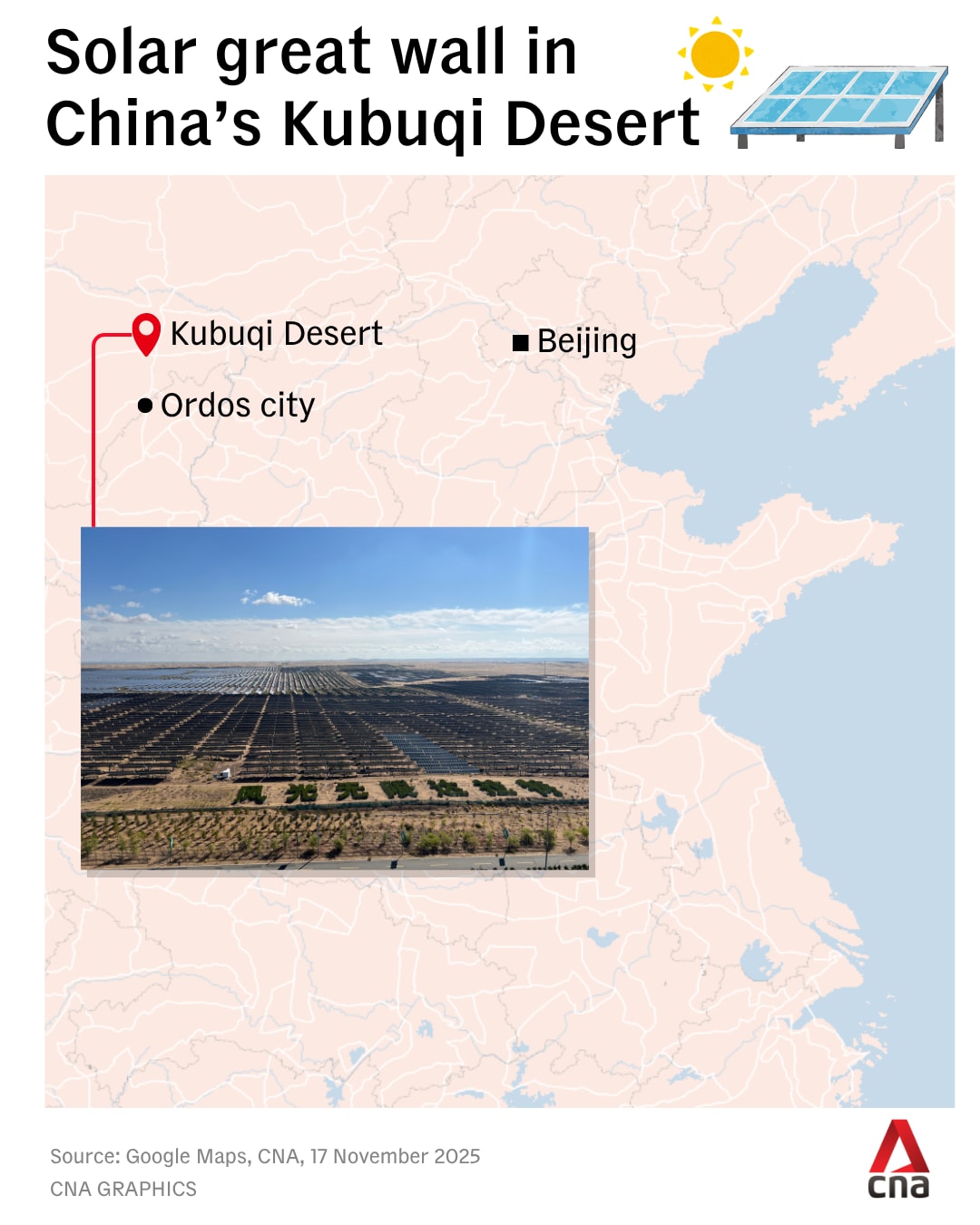From seeding drones to solar farms: A look at China’s battle against desertification
As of 2024, 53 per cent of China’s desertified land has been reforested or stabilised.

Solar panels at what has been dubbed the Solar Great Wall at the Kubuqi Desert, Inner Mongolia, China. (Photo: CNA/Tan Si Hui)

This audio is generated by an AI tool.
ORDOS, Inner Mongolia: A glistening sea of solar panels stretches across 400km of sand dunes in the vast Kubuqi Desert, located on the edge of Ordos city in China’s Inner Mongolia autonomous region.
The massive project, dubbed the Solar Great Wall, is poised to become one of the largest solar power installations in the world once completed by 2030.
According to local officials, the site will supply clean power to Beijing and its surrounding areas, reinforcing China’s broader ambitions to transition to green energy.
It is also a striking example of the country’s use of technology in its fight against desertification, which has long threatened its arid northern regions.
Beyond its role in clean energy production, the Solar Great Wall will serve to stabilise the Kubuqi Desert’s sands and provide a shield from the wind, creating optimal conditions for shrubs to grow.
This is part of a broader strategy to prevent land degradation in the north caused by water shortages and human activities.
Kubuqi Desert, once called the “sea of death”, was plunged into desertification when centuries of grazing stripped the land of all vegetation. Since 1988, a Chinese firm has been working with locals and the Chinese government to combat the problem.

“After three to four years, or even longer, once the plants have truly taken root, they’ll be able to survive on their own,” said Dalad Banner Energy Bureau staff member Yang Chao.
Yang noted that there is abundant land in the desert for large-scale construction, with nearly 2,000 hours of sunlight every year.
“With 1 gigawatt of capacity, we generate nearly 2 billion kilowatt-hours of clean electricity annually, saving about 560,000 tonnes of standard coal and cutting carbon dioxide emissions by 1.56 million tonnes,” he told CNA.
DRONES IN THE DESERT
In recent years, new technology has intensified China’s efforts to hold back its desert.
Drones have replaced workers in scattering grass seeds in Ordos, reducing the need for back-breaking manual planting in harsh conditions where sand is constantly blown into workers’ faces.
These efforts are showing results.
As of last year, 53 per cent of China’s desertified land has been reforested or stabilised. The area of such desertified land has decreased by about 4.3 million hectares since 2012.
The country has also become the first in the world to achieve zero net land degradation, even reducing areas that have been desertified.
China’s environmental progress has drawn global attention, particularly as the United States has rolled back climate policy under US President Donald Trump’s administration.
“I would say China will be the global leader in sustainability by design or even by default. And I think this gels very well with the combination of their domestic policy as well as their international commitment beyond just carbon,” said Professor Lawrence Loh, director of the Centre for Governance and Sustainability at NUS Business School.
“For example, they are greening the Belt and Road Initiative, and also interacting with other initiatives beyond just the environment,” he added, referring to China’s massive infrastructure project that aims to transform world trade.
GREEN GOALS
Ahead of the COP30 summit in Brazil that kicked off last week, Chinese President Xi Jinping announced that China would cut greenhouse gas emissions by 7 to 10 per cent by 2035 - marking the country’s first absolute emissions reduction target.
He also pledged to expand China’s installed wind and solar capacity while increasing the share of cleaner fuels in its energy mix.
Loh said this must go in tandem with real action in raising the share of non-fossil fuels in China’s energy mix.
“Going forward, they probably need to coordinate with other countries to invigorate the voluntary carbon markets,” he added, in reference to markets where individuals and companies can voluntarily purchase carbon credits to offset their greenhouse gas emissions.
He noted: “And of course, China will need to participate in the Paris Agreement carbon markets … What I feel is that sometimes, China tends to under-promise and over-deliver.”
Still, experts said there could be spillover benefits for other nations.
“In the United Nations Sustainable Development Goals dashboard, China has a high spillover score of 90.14 out of 100,” said Loh.
“This reflects that its actions in trade, finance and security lead to positive environmental and social impacts, which in turn strengthen other countries' abilities to achieve the sustainable development goals."
Green development remains a key focus in China’s latest five-year social and economic road map, with officials pledging to strengthen international collaboration in green technology.


















